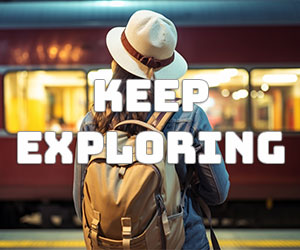If you are getting tired of visiting the same old parks in New York City, or have paid a visit to Central Park countless times before, perhaps it is time to venture out and explore some of New York City’s waterfront parks instead.
New York City’s waterfront parks offer something different from other park around the Big Apple – a chance to get upclose or take in sights of the water. Often bustling with water craft moving back and forth, the water around New York City is a hive of activity and provides a different dimension of big city life.
Yet, a walk along waterfront parks in New York City can also be a chance to unwind and let your mind relax and find some mental space to recenter yourself.
Here is a selection of some of our favourite New York City waterfront parks to visit.
Best New York City Waterfront Parks
Battery Park City

Battery Park City is a high-rise residential neighbourhood on the west side of Lower Manhattan. With the Hudson River Park promenade running along the Hudson River, it was constructed on landfill that reclaimed land from river.
At Battery Park City, you will also find a number of outdoor eateries with breathtaking views of the Statue of Liberty from Manhattan. Perfect if you wish to just soak in the views while visiting this waterfront park.
Don’t miss the SeaGlass carousel if you have kids.

Families will also appreciate the fantastic 1.8-acre Teardrop Park with its long slide and play elements, along with the broad lawn at the northern section of the park. The park opened in September 2004 and is one of several found at Battery Park City.
Getting to Battery Park City
By subway: South Battery Park: 1, R, W to Rector Place; 4, 5 to Bowling Green.
North Battery Park: 1, 2, 3, A, C to Chambers Street; E to World Trade Center. By bus: M9, M20, M22.
Brooklyn Bridge Park
Brooklyn Bridge Park runs from Vinegar Hill to Brooklyn Heights. This was formerly an industrial site that has been transformed into an 85-acre, 1.3-mile-long park with grassy lawns, rocky outcrops, bike paths, playgrounds, sports fields, basketball courts, and a carousel.
There are playgrounds, picnic areas, temporary food stands by renowned restaurants, summertime music and film festivals, and water taxi service to Governors Island.
Thousands of tourists and residents who take advantage of the space and facilities of the waterfront park each year. One of the draw is the the picture-postcard views of the Brooklyn and Manhattan Bridges and the Manhattan skyline.
Getting to Brooklyn Bridge Park
By subway: A, C to High Street; F to York Street. Instead of taking the subway, you can take a water taxi to Fulton Ferry Landing. Or an alternate water borne option is the the East River Ferry to Fulton Ferry Landing.
Another popular way to reach Brooklyn Bridge Park from Manhattan is by walking across the Brooklyn Bridge.
East River Park
One of the Lower East Side’s best-kept secrets is this beautifully landscaped waterfront park, which stretches from Montgomery Street to 12th Street along the Manhattan side of the East River.
The Lindsay East River Park, often just called the East River Park, has ball fields, bike paths, tennis courts, playgrounds, gardens, and picnic areas, as well as stunning views of the Brooklyn skyline and the Williamsburg Bridge.
The park was one of the Lower East Side’s largest open green space. Even though the park has been encroached upon by a number of construction projects, including the enlargement of South Street and the widening of FDR Drive, it still remains so.
The East River Park offers a haven for locals, especially during the summer when the river’s cooling breezes are most welcome.
To access the park, you must cross a footbridge over FDR Drive.
Getting to East River Park
By subway: J, M, Z to Essex Street; F to and Avenue. By bus: M14D, M21, M22.
Governors Island

Only 800 yards from the tip of Manhattan, this tiny island has the feel of a small town. Both locals and visitors adore the out-of-the-city experience. Tourists adore the unrivalled views of Lower Manhattan and the New York Harbour.
The 172-acre park was constructed in part using landfill from subway excavations.
Governors Island served as a base for the U.S. Army and Coast Guard for almost 200 years. It wasn’t open to the public until 2003, which may be why the 19th-century houses here are so well preserved.
From May to October, the island is open every day to the public, and there are events for the whole family as well as art exhibits and musical performances.
On the ferry or on the island, you can rent a bike and ride over.
Visit www.govisland.org for more details, including updated ferry schedules and an events calendar.
Getting to Governors Island
You can take a seven-minute ferry ride (free on weekend mornings) to get across from Lower Manhattan to Governors Island. Take the the ferry from the dock at the restored, cast-iron Battery Maritime Building (10 South Street), near the Staten Island Ferry.
Get to the ferry by subway: 1 to South Ferry; 4, 5 to Bowling Green; or R, W to Whitehall Street. By bus: M15, M20, M55.
The High Line

The High Line, a linear park that incorporates landscaping with rail-inspired design and offers a new perspective on the city, was once an elevated railway track that served the long-gone factories along the lower west side.
The park is set 30 feet above street level between Gansevoort Street in the Meatpacking District and 34th Street in Midtown.
Be aware that the park is frequently very crowded, particularly on weekends and in the afternoons.
Highlights include expansive views of the Hudson River, a clear view of the Meatpacking District, and the Whitney Museum of American Art.
There are also 210 species of plants, trees, and shrubs that make up the vegetation on The High Line and they were chosen to mimic the wild plants that survived for many years after the tracks were abandoned in 1980.
For more information on public programs and an events calendar, visit www.thehighline.org.
Getting to The High Line
The High Line is accessible at Gansevoort and every two blocks between 14th and 30th Streets, with elevator access at 14th, 16th, 23rd, 30th, and 34th Streets; no bikes are allowed.
You can also reach it by going two blocks west of the subway station at 14th Street and 8th Avenue, served by the A, C, E, and L.
Alternativley, take the C, E to 23rd Street and walk two blocks west. The 1, 2, 3 stops at 14th Street and 7th Avenue, three blocks away.
By bus: M11, M14D, M23, M34.
Hudson River Park

The Hudson River Park is a 5-mile greenway park from 59th Street to Battery Park. The waterfront park is divided into seven separate areas that represent the various Manhattan neighbourhoods directly across the West Side Highway.
There are attractions like the Intrepid Sea, Air & Space Museum at Pier 86 across from 46th Street in addition to renovated piers with grass and trees.
Pay a visit to Little Island, a free public park pier within the larger Hudson River Park, which gives New Yorkers and tourists from all over the world a distinctive green space unlike any other in the city.
The Circle Line and World Yacht provide boat tours of the Hudson a few blocks south.
For those who wish to get on to the water, the Downtown Boathouse provides free kayaking at Piers 96 and 40.
Between Piers 59 and 61, there is a sizable sports complex called Chelsea Piers.
Over at Pier 25, there is a playground, a mini-golf course, and a beach volleyball court.
Additionally, the park offers free classes, tours, and fishing opportunities.
For a calendar of events and activities, go to www.hudsonriverpark.org.
Getting to Hudson River Park
Hudson River Park is next to the West Side Highway.
Crosstown buses at 14th, 23rd, and 42nd Streets will get you close, but you’ll still have to walk a bit.
Riverside Park
From 72nd to 156th Streets, Riverside Park offers peace and quiet along the Hudson River on the Upper West Side, as does the park’s southern extension, which runs roughly from 55th to 66th Streets.
The waterfront park in NYC was originally laid out between 1873 and 1888 and designed by Central Park luminaries Frederick Law Olmsted and Calvert Vaux.
You can enjoy bike and walking paths at the original Riverside Park sections.
There are a number of entrances to the park, including one at West 72nd Street and Riverside Drive (look for the Eleanor Roosevelt statue), where you can access the waterfront path through an underpass under the West Side Highway.
Once past the 79th Street Boat Basin, where a flotilla of houseboats bobs in the water, you can continue travelling north along the Hudson River.
Getting to Riverside Park
By subway, 1, 2, 3 to 72nd St.
We hope that you’ve enjoyed these ideas of waterfront park in New York City that you can visit and enjoy.
You may also be interested to read about Governors Island, the park in the middle of New York Harbor.


